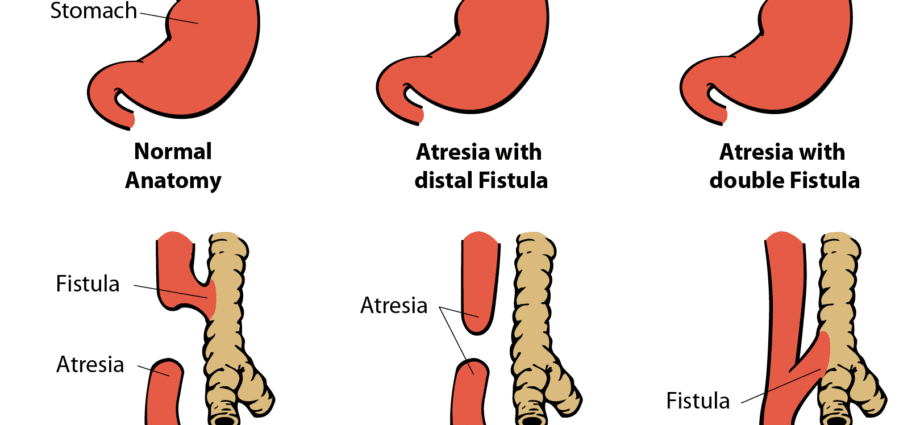Contents
General description of the disease
Atresia is the absence of a natural opening (channel) in the human body, congenital or acquired.
Depending on which hole is missing, this type and atresia are distinguished.
Classification of atresia, its characteristics, causes and symptoms of each type:
- anus (the opening between the anus and the rectum is abnormally developed) – it is revealed during the examination by a doctor, the child has a swelling of the tummy, regurgitation of gastric juice, no gas and meconium, the reasons are heredity, abnormal intrauterine development (disruptions in the woman’s body or illness during the period when fetal development is in progress);
- auricle (microtia – underdeveloped auricle), the reason is the side effects of drugs during pregnancy of the mother, hereditary anomalies of the ears;
- bile ducts (obstruction or absence of pathways that excrete bile) – the main signs: the skin, the sclera of the eyes are yellow, urine of a dark color, resembles “dark beer”, but at the same time the feces are discolored, 2 weeks after birth, the size of the liver increases, has a congenital character ;
- hoan (the opening between the nasopharynx and the nasal cavity is partially or completely filled with connective tissue); the main symptom is acute respiratory failure, which is mainly inherited;
- esophagus (the upper esophageal segment blindly ends) – the reason is not the separation of the trachea and the esophagus at the 4th week of embryogenesis, during pregnancy, mothers have an increased fluid content in the womb and in the first trimester there may be threats of miscarriage; in a child, atresia manifests itself in the form of large discharge from the nasal and oral cavity in a child, when trying to feed, food comes back or enters the respiratory tract;
- small intestine (with this type of atresia, the blind ends are completely disconnected and have a mesenteric defect) – reasons: genetic predisposition, diseases of the fetus in the womb, as a side effect of medications that the mother took during pregnancy, early childbirth; main signs: volvulus, intestinal process disturbed, peritonitis;
- follicles (ovarian follicles that have not reached maturity are developed in the reverse order) – arises from an insufficient amount of gonadotropic hormones, it can manifest itself in the form of disruptions in the menstrual cycle, polycystic ovaries, bleeding, amenorrhea;
- pulmonary artery (there is no normal connection between the pulmonary artery and the right ventricle – this is due to the presence of a congenital heart defect);
- tricuspid valve (there is no communication between the right ventricle and the right atrium due to congenital heart disease);
- vagina (vaginal walls are spliced) – manifests itself in the form of hematometry, mucocolpos, hematocolpos, inability to have sexual intercourse; causes of congenital atresia: the mother had mycoplasmosis, genital herpes, papilloma virus, ureaplasmosis, trichomoniasis, the causes of secondary (acquired) atresia are previous operations on the genitals, birth trauma, persistent colpitis, sometimes, atresia occurs in girls after undergoing scarlet fever, parotitis, or dipytheria (These diseases give complications in the form of an adhesive inflammation of the vagina). The main signs are colpitis, dysbiosis, itching, amenorrhea can be diagnosed, but it is often false, there is no outflow of secretions.
Healthy foods for atresia
Basically, atresia is a congenital disease, it is acquired due to pathological processes in the body or improperly performed surgical interventions (this occurs only in several types of atresia, for example, vaginal).
Treatment is possible only with the help of surgical interventions; this disease cannot be cured on its own.
Operations to eliminate a defect of a congenital nature are carried out at an early age (up to several months of children), therefore there are no necessary measures for special nutrition. The baby should be given mother’s breast milk and baby food recommended by medical institutions and according to the age category.
In the future, a person who has had this disease should focus on products that contribute to the work and support of the functioning of the organ (channel) where the operation was performed.
Traditional medicine for atresia
Treatment of the disease is carried out in the early stages of a child’s life, therefore, treatment with herbs and fees is contraindicated.
After plastic surgery for vaginal atresia, it is necessary to insert daily tampons made of gauze bandage and lubricated with vaseline oil, wash with chamomile and calendula infusions.
With age, the child can be carried out phytoprophylaxis to strengthen the body and organs, depending on where the operation was performed.
Dangerous and harmful foods for atresia
From an early age, the child should be taught to proper nutrition. It is recommended to limit the consumption of sweet, fatty, salty, spicy foods (especially it is worth saving the stomach for those people who have had esophageal atresia), to give up semi-finished products, fast foods and other non-living foods.
Naturally, you should not acquire bad habits.
Attention!
The administration is not responsible for any attempt to use the information provided, and does not guarantee that it will not harm you personally. The materials cannot be used to prescribe treatment and make a diagnosis. Always consult your specialist doctor!










